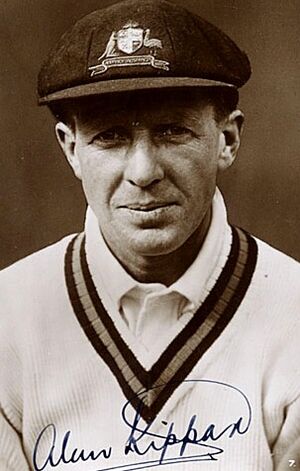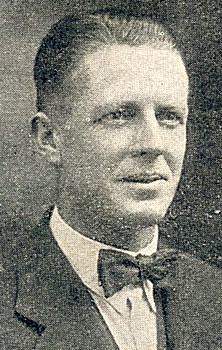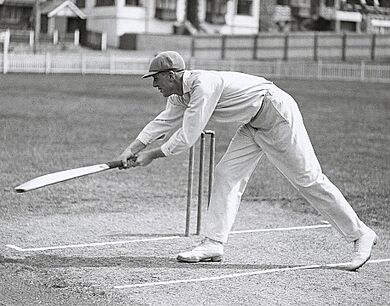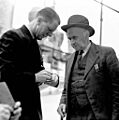Alan Kippax facts for kids

Kippax in 1930
|
||||||||||||||||||||||||||||||||||||||||
| Personal information | ||||||||||||||||||||||||||||||||||||||||
|---|---|---|---|---|---|---|---|---|---|---|---|---|---|---|---|---|---|---|---|---|---|---|---|---|---|---|---|---|---|---|---|---|---|---|---|---|---|---|---|---|
| Full name |
Alan Falconer Kippax
|
|||||||||||||||||||||||||||||||||||||||
| Born | 25 May 1897 Paddington, New South Wales, Australia |
|||||||||||||||||||||||||||||||||||||||
| Died | 5 September 1972 (aged 75) Bellevue Hill, New South Wales, Australia |
|||||||||||||||||||||||||||||||||||||||
| Nickname | Kip | |||||||||||||||||||||||||||||||||||||||
| Batting | Right-handed | |||||||||||||||||||||||||||||||||||||||
| Bowling | Right-arm wrist spin | |||||||||||||||||||||||||||||||||||||||
| Role | Middle-order batsman | |||||||||||||||||||||||||||||||||||||||
| International information | ||||||||||||||||||||||||||||||||||||||||
| National side | ||||||||||||||||||||||||||||||||||||||||
| Test debut (cap 122) | 27 February 1925 v England | |||||||||||||||||||||||||||||||||||||||
| Last Test | 22 August 1934 v England | |||||||||||||||||||||||||||||||||||||||
| Domestic team information | ||||||||||||||||||||||||||||||||||||||||
| Years | Team | |||||||||||||||||||||||||||||||||||||||
| 1918/19–1935/36 | New South Wales | |||||||||||||||||||||||||||||||||||||||
| Career statistics | ||||||||||||||||||||||||||||||||||||||||
|
||||||||||||||||||||||||||||||||||||||||
|
Source: CricInfo, 8 January 2008
|
||||||||||||||||||||||||||||||||||||||||
Alan Falconer Kippax (born May 25, 1897 – died September 5, 1972) was a famous Australian cricket player. He played for New South Wales (NSW) and the Australian national team. Kippax was known for his elegant batting style between World War I and World War II.
Even though he started playing Test cricket a bit later, he became a regular player for Australia from 1928 to 1933. He was a batsman who usually batted in the middle of the team's lineup. Kippax toured England twice with the Australian team. In Australia, he scored many runs and was a respected leader for NSW for eight years.
His scores in Test matches were not always as high as his amazing scores for NSW. He is best remembered for a world record partnership in a domestic game. This happened in a Sheffield Shield match in 1928–29. His career was affected by the "Bodyline" bowling tactics used by England in 1932–33. Kippax even wrote a book against these tactics after the series.
Kippax was known for his "correct and elegant" batting. He stood tall and relaxed at the wicket. Like his hero Victor Trumper, he was great at the late cut shot. He was left out of the team for the 1926 tour to England, which caused a big stir. This was especially true after he scored an amazing 271 not out against Victoria just before the team was chosen. Kippax was already in his thirties when he became a regular Test player.
Contents
Early Life and Cricket Beginnings
Alan Kippax was born in Paddington, a suburb of Sydney. He was the third son of Arthur Percival Howell Kippax and Sophie Estelle. Alan went to Bondi and Cleveland Street Public schools.
When he was 14, Kippax joined the Waverley (now Eastern Suburbs Cricket Club). Within three years, he was playing for the first-grade team. At this time, first-class cricket was paused because of World War I. When games started again in the 1918–19 season, he played his first match for New South Wales (NSW).
NSW had many talented batsmen. This meant Kippax did not get many chances to play for a few seasons. He also played a lot of baseball for the Waverley Baseball Club. He usually played at third base and even represented Australia against teams from American universities.
People quickly noticed Kippax's cricket talent. He was offered a tour of New Zealand in 1921. He played for an Australian second team. He scored only two half-centuries in nine innings on that tour. In the 1922–23 season, Kippax became a regular player for NSW. He scored 631 runs at an average of 90.14. He was the top scorer for the team that season.
The next season, he scored 248 runs in just 316 minutes against South Australia. This happened at the Sydney Cricket Ground (SCG). Then, he toured New Zealand again with the NSW team. Kippax made two centuries and scored 461 runs (average 92.2) on that tour.
Kippax quickly earned the respect of other players and fans. He was known for his calm and proper way of playing. Cricket writer Alan McGilvray said Kippax was "meticulous in his dress and his life." He was a "man with a squeaky-clean image." He never raised his voice or let his feelings get out of control.
Journalists used many great words to describe Kippax's style. Ray Robinson said Kippax's batting "had a silky quality." He charmed crowds with his late cut shot. His favorite hook shot made the ball fly "with such unhurried ease." Donald Bradman thought Kippax was the best at the hook shot.
Playing for Australia

Kippax started the 1924–25 summer well. He scored 115 runs for NSW against an Australian XI at the SCG. In the Sheffield Shield, he had scores of 127, 122, 31, 212 not out, and 40. These scores earned him his first chance to play for Australia. He was 27 years old.
He played in the final Test match of The Ashes series against England in Sydney. Kippax scored 42 runs from number seven. He shared a 105-run partnership with Bill Ponsford. Wisden said this partnership "turned the fortunes of the game." Australia went on to win the match.
A Surprising Omission
Kippax scored another 585 runs at an average of 83.57 in the 1925–26 season. This seemed to guarantee him a spot on the team to tour England in 1926. He did not do well in the Test-trial match in early December. However, he made the highest score of the Sheffield Shield. He scored 271 not out (in 423 minutes) against Victoria at the SCG. This helped NSW win the title.
But Kippax was left out of the touring team. This decision is seen as a big mistake in Australian cricket history. Even though Kippax was almost 29, former Australian captain Monty Noble called it a "crime." People thought his omission was due to "interstate favoritism." Australia lost the Ashes on that tour. Much of the blame went to the team's captain, Herbie Collins. After Collins returned, he lost his captaincy for his club and NSW. This gave Kippax a chance to lead.
Leading New South Wales
Kippax became the captain of NSW. Over the next three years, he became known as one of Australia's top batsmen. His captaincy helped a new team become very strong. He guided young players like Archie Jackson, Stan McCabe, and Donald Bradman.
He scored a century in each innings against Queensland in their first Sheffield Shield match in 1926–27. The next season, he made his highest score ever, 315 not out in 388 minutes. This was against Queensland at the SCG. Bradman wrote that it was hard to imagine more graceful batting than Kippax's that day. Kippax finished the season with 926 runs at an average of 84.18.
The Test selectors were still watching Kippax. In March 1928, he toured New Zealand again with an Australian second team. But he did not score more than 40 runs in any of his seven innings. He was back in the Test team for the start of the 1928–29 Ashes series. Kippax made only 50 runs in four innings. Australia lost two games badly, but Kippax's spot was safe.
During the second Test in Sydney, Kippax was part of a very talked-about moment. Early in Australia's first innings, Kippax had nine runs. The umpire at the bowler's end said the ball missed Kippax's legs. But the bails fell. The umpire did not give him out. Then, another umpire gave Kippax out "bowled." This umpire was in the wrong position to make that call. It seemed the ball bounced off the wicketkeeper's pads onto the stumps. Kippax left the field because an English player kept telling him he was out. The umpire later admitted his mistake.
After the Test, Kippax went to Melbourne. He led NSW in a Sheffield Shield match starting on December 22. At the end of the second day, NSW was in trouble. They were seven wickets down for 58 runs, chasing Victoria's 376. On Christmas Day, NSW lost two more wickets and were nine for 113. Kippax was 20 not out. However, the last batsman, Hal Hooker, stayed with his captain.
The score slowly grew, and the other team became frustrated. As news of their partnership spread, the crowd grew to almost 15,000. Kippax's early nerves about his partner disappeared. Kippax would hit as many runs as he could from the first few balls. Then he would take a single run to let Hooker face the remaining balls. He played his innings perfectly.
By the end of the day, Kippax had scored more than 200 runs. The next day, their partnership finally ended after 307 runs were added in 304 minutes. Kippax was 260 not out. This "most remarkable of all world batting records" is still the highest last-wicket partnership in first-class cricket today.
Kippax kept his place for the third Test, which started days later. He continued his great form. He scored his first Test century in Australia's first innings. Australia was struggling against England's fast bowler, Harold Larwood. Kippax steadied the innings. Then he attacked Larwood, hitting him for four boundaries. A journalist noted that before Kippax's quick runs, Larwood had taken many wickets. After, he took far fewer. Kippax then scored 41 runs in the second innings. Australia lost their third game in a row and lost the Ashes.
Kippax finished the series with scores of 3 and 51 in Adelaide. He scored 38 and 28 in Australia's only win, at the MCG. Some people criticized his play, saying it was "too delicately tuned for the hard business of winning matches." Still, Kippax had another great domestic season in 1929–30. He scored four centuries and 744 runs, averaging 62. This time, he was one of the first players chosen to go to England.
A Regular Test Player
The 1930 tour of England was mostly about the rise of Don Bradman. Kippax was second only to Bradman in runs scored and averages in first-class games. He scored 1451 runs at an average of 58.04. He scored a century in both innings of the match against Sussex. In the Test matches, Kippax scored over fifty runs four times in seven innings. But he did not reach a hundred. He had two big partnerships with Bradman: 192 runs at Lord's and 229 runs at Leeds.
Wisden said his 64 not out on a wet wicket in the first Test at Nottingham was his best effort. They described his tour: "Kippax was a great batsman, for he could change his game to fit the situation." He was a beautiful driver of the ball and could cut it well.
In the 1930–31 home series against the West Indies, Kippax started with his highest score in Test cricket. He scored 146 runs in under four hours in the first Test at the Adelaide Oval. This was the first Test century ever scored in matches between Australia and the West Indies. He made 84 runs in the third Test in Brisbane. He shared a 193-run partnership with Bradman. However, Wisden called Kippax's innings "unsteady." He did not score well in his other three Test innings. For NSW, he scored two centuries in the Sheffield Shield.
The next season started badly for Kippax. He was playing in a small match in Parkes. He broke his nose when a ball bounced strangely. On November 6, 1931, during NSW's first match of the season, he was hit hard on the head by a fast ball. He was taken to the hospital and left the match. But he was still chosen for the first Test against South Africa. He only scored one run. He missed the second Test due to injury. His replacement, Keith Rigg, scored a century on his first game.
Kippax returned for the third Test in Melbourne. He showed the selectors they made the right choice by scoring 52 and 67 runs. These were his two highest first-class scores of the season. His best knock of the summer came on another rain-affected pitch in Melbourne in the final Test. He batted "serenely" and was the top scorer with an elegant 42 runs. The entire South Africa team scored only 36 and 45 runs in their two innings on a "treacherous" wicket. Kippax led NSW to victory over Victoria in late January. This win secured the Sheffield Shield title for NSW. In 1932, Kippax joined a private team that toured Canada and the USA. His teammates noticed that the hits to his head had affected his confidence. He no longer used his famous hook shot.
The Bodyline Series
England toured Australia during the 1932–33 season. They played the famous "Bodyline" series. This tactic involved using short-pitched bowling and many fielders close to the leg side. It was first planned to stop Don Bradman's amazing scoring. But Bodyline was used against all Australian batsmen. Kippax and other Australian batsmen were good at playing long innings and helping Bradman score big partnerships. So, the English team wanted to shake Kippax's confidence too.
Kippax secured his Test spot by scoring 179 runs against Queensland in November 1932. Two weeks later, he led NSW against the English tourists. He did not score well in either innings, and his team lost badly. He was chosen for the first Test in Sydney. Kippax looked very uncomfortable and lost his wicket twice to England's main Bodyline bowler, Harold Larwood.
After batting at number four in the first innings, Kippax was moved down to bat after his NSW teammate Stan McCabe in the second innings. McCabe had scored a brilliant 187 not out in the first innings, hitting aggressive hook shots against Bodyline. Despite the change, Australia scored only 164 runs. England needed just one run to win. In the dressing room, Kippax said Larwood was "too fast for me."
Kippax was left out of the rest of the series. He was one of several Australian batsmen who struggled that summer. Most people felt sorry for him. They thought his lack of confidence was due to the hits he received the previous season. Larwood, however, said Kippax "was scared stiff." Kippax worked as a radio commentator. He covered the rest of the series. He also gave a ten-minute summary of each day's play for the BBC.
Kippax openly criticized Bodyline. He teamed up with cricketer and doctor Eric Barbour to write the book Anti Body-Line. It was released just months after the tour. This short book was for English readers. It warned about the danger to cricket if Bodyline was allowed. The book kept the argument going, but it was written in a "calm" and "reasonable" way.
After a few seasons of not scoring many runs, Kippax played well again in 1933–34. Against Queensland, he scored 125 runs. He shared a 363-run partnership in just 135 minutes with Bradman. In total, he scored four centuries and averaged almost 72. This earned him a spot on the 1934 tour of England. Bradman was chosen as the vice-captain instead of Kippax. But Kippax knew that the Australian Board of Control and the MCC had agreed that Australia would not face Bodyline during the tour.
Final Tour and Legacy
Kippax started the 1934 tour with a duck (no runs). He then scored 89 runs at Leicester. But he got a bad case of influenza and missed the next four matches. When he returned, he struggled to score runs. He was not chosen for the first Test. Kippax was one of the three selectors on tour. He was out-voted by the others. The press thought this caused problems in the team. Australia won the first game. Kippax did not do well in the next two tour matches, so he missed the next Test at Lord's, which Australia lost.
Kippax became seriously ill again. He was in the hospital with a suspected case of diphtheria (which was later found to be wrong). He missed the drawn Tests at Old Trafford and Leeds. He finally returned to play in late July and started scoring runs well. The series was tied at one win each. A timeless Test was to be played at The Oval to decide the Ashes. Australia needed stronger batting. The experienced Kippax replaced the struggling young player Len Darling in the middle order. This was his last Test match.
In that game, Kippax did not have much to do with the bat. A record partnership of 451 runs between Bill Ponsford and Don Bradman meant Australia was four wickets down for 574 runs when he came to bat. Kippax made 28 runs in just under an hour. Australia scored a massive 701 runs. He scored only 8 runs in the second innings. But Australia won by 562 runs and got the Ashes back. Six days later, Kippax scored 250 runs against the Sussex bowling attack. This was his highest score in England and his first double century in over five years. This boosted his first-class average to over 50 on what had been a mixed tour.
When the team returned from England, Kippax gave the NSW captaincy to his teammate Bert Oldfield. He finished his first-class career with four more Sheffield Shield matches for NSW. His last century came in December 1934. He scored 139 runs against South Australia at the Adelaide Oval. This gave Kippax a total of 32 centuries for NSW, a record at the time. Only Michael Bevan has scored more since then. His 6,096 runs (at 70.06 average) for NSW in Sheffield Shield matches helped the state win five titles. Besides his 12,792 first-class runs, Kippax scored over 7,000 runs at an average of 53 for his club, Waverley.
Don Bradman summarized Kippax's importance in Australian cricket: "This beautiful and stylish player was unlucky to start playing big cricket when NSW had an almost international team." When he did get his chance, Alan was a true hero. His elegant style, like Victor Trumper's, surely inspired many young boys. The style of Trumper and Kippax has a lot to do with the grace often seen in players from NSW.
Kippax captained NSW in 45 first-class matches. He won 19, drew 17, and lost only nine. In early 1937, his commentary of the fourth Test in Adelaide made history. It was the first direct radio broadcast of a cricket match from Australia to England.
Personal Life
After working as a clerk for a while, Kippax opened a sports store in Martin Place, Sydney, in 1926. It became a very successful business. Two years later, on April 20, 1928, he married Mabel Charlotte Catts. The New South Wales Cricket Association made him a life member in 1943–44.
In February 1949, Kippax was given a special match to honor his career, along with his old teammate, wicketkeeper Bert Oldfield. This match was played between Lindsay Hassett's XI and Arthur Morris's XI at the Sydney Cricket Ground. It raised £6,030, which was split evenly between Kippax and Oldfield. In his later years, Kippax was a good golfer and a club champion lawn bowler.
Kippax was described as a "small, gentle man with a kindly way." He had a great reputation in cricket. He was known as "a man of personal charm." He was as elegant off the field as he was on. Cricket writer David Frith said visiting him felt like stepping into a calm 1930s world. Kippax died of heart disease at his home in Bellevue Hill on September 5, 1972. Kippax Fair in the Canberra suburb of Holt is named after him.
He was the uncle of the theatre critic Harry Kippax.
Images for kids






